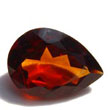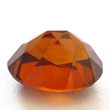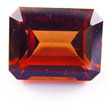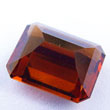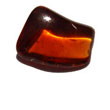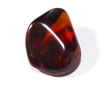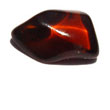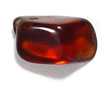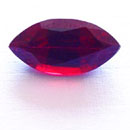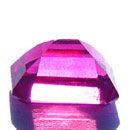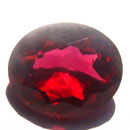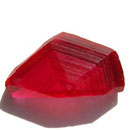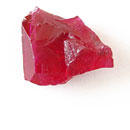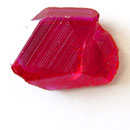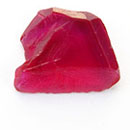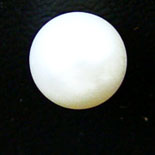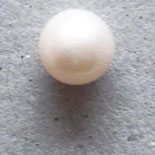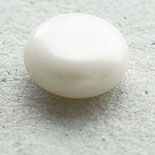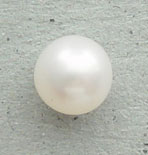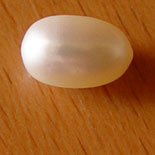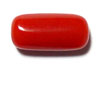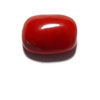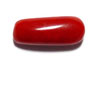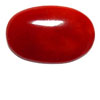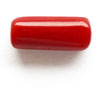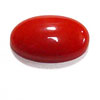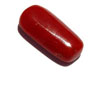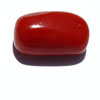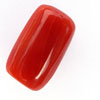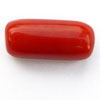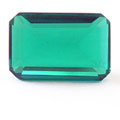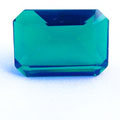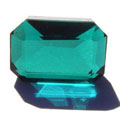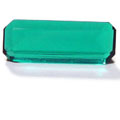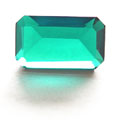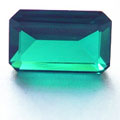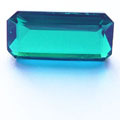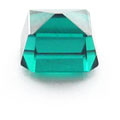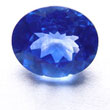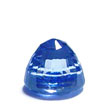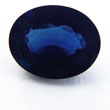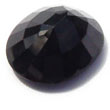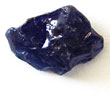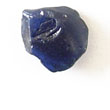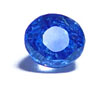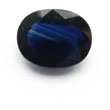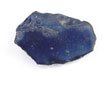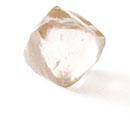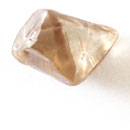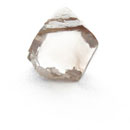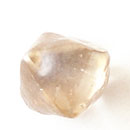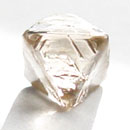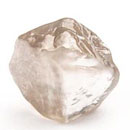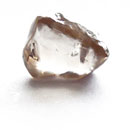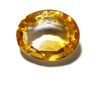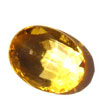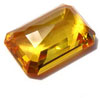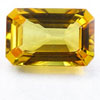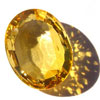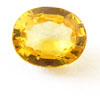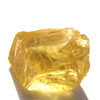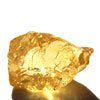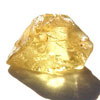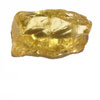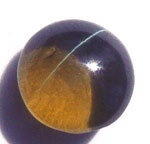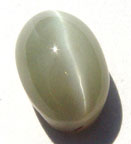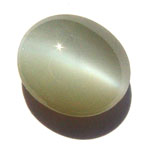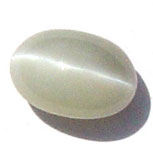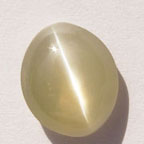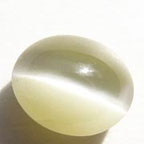As discussed, a gem's type, weight,
size, clarity, and manner of contact are among the pertinent
factors that affect its ability to mitigate or nullify
negative planetary influences. The main consideration for
the customer will of course be price.
Over the years I have been trying to
offer effective astrological gems for the lowest possible
price so that even the small budget can afford the "luxury" of
utilizing this blessed system of karmic mitigation. I
am happy to report that great success has been attained
often by unconventional means.
The hessonite garnet provides an excellent
example of the controversy surrounding gem costs and demonstrates
how I have been able to keep the cost of navaratnas so
manageable. The common hessonite is a roiled (heat waved),
dark brandy-colored gem that retails for about $35 a carat.
It is the easiest to procure, but seems to have little
or no karmic mitigating effects (a recurring observation
from my clients). Golden Hessonite, recommended by some
very respected Vedic astrologers, is a clear and beautiful
stone when not included. This stone, however, is not referred
to in the Vedas, as it only began to appear on the market
about twenty years ago, having been mined in Sri Lanka
and Canada. I believe its similar atomic matrix must be
advantageous but when the hessonite is referred to as cinnamon
stone in the Vedas, that can only mean one limited range
of color. Of the cinnamon stones, the highest-quality hessonite
that is not roiled or included, over two carats is rare
and costs over $85 a carat. Often it is confused with Almandine
(Almandite), Malaia, Spessartite garnets or Brandy topaz
(Madeira) and stained quartz. Though a few astrologers
may advise substitutes, my studies advise this as a last
resort.
Because volume, clarity, and color are
the main factors of potency, (as most scholars of Vedic
prescriptions believe), I make available high-quality,
deep cinnamon colored hessonite for about $10 a carat.
The reason for its relative inexpensiveness is its shape.
These gems are polished and smooth-edged specimens that
do not have the correct dimensions for large-stone conventional
faceting. Therefore, they are not as marketable. They do
however have excellent astrological strength. I am extremely
happy to have located this supply after three years of
searching. It is this type of patience, commitment and
expertise which allows me to develop financial savings
resulting in relatively inexpensive gem bangles - of high
quality - for my customers.
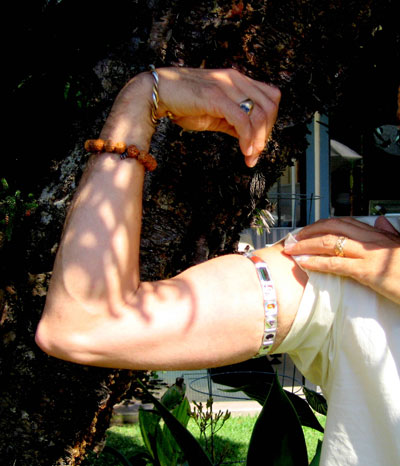 Many people still believe that high-quality
gems must cost a king's ransom. But in this age of dynamite,
excavators, and mechanized mineral processing technology,
what once came to rest with wealthy collectors is now much more
affordable. Laboratories, using revolutionary techniques
to copy Mother Nature's gem growing environment, have greatly
expanded the supply of top quality gem material, and thereby
reduced its cost. Many people still believe that high-quality
gems must cost a king's ransom. But in this age of dynamite,
excavators, and mechanized mineral processing technology,
what once came to rest with wealthy collectors is now much more
affordable. Laboratories, using revolutionary techniques
to copy Mother Nature's gem growing environment, have greatly
expanded the supply of top quality gem material, and thereby
reduced its cost.
The ruby illustrates another unorthodox
approach that I have developed over the years. Many Vedic
astrologers, because they are not trained gemologists,
have an erroneous viewpoint about the catagorizing of "synthetic" stones.
It is imperative that the reader understand that what I
use and recommend are laboratory-grown crystals. These
lab-grown gems (also called created gems) are not to be
confused with common synthetics. Synthetic stones for the
most part, are materials similar in color or chemical composition
to the natural, but have no synonymous crystal structure,
and by application, no remedial power. Many synthetic gems
are often misrepresented as having been grown as crystals
in a laboratory. Retailers very commonly appear to not
be completely accurate in this regard. A large laboratory-grown
crystal can be grown from a smaller natural crystal.
Is this any more unnatural than a seed grown in a greenhouse?
Though I sell natural (and expensive) rubies and emeralds,
my client feedback reveals that much more benefit is gained
by those who wear lab-grown gem quality crystal material.
The reason being, a deep green laboratory grown emerald
is 1/40th the price of natural emeralds and because of
budget limitations, clients invariably purchase a much
more included and less intensely green natural gem.
The laboratory crystals of today grow
using the same laws of nature that are activated when natural
crystals are grown in magma or other thermal strata (the
way natural gems originate). Actually, gems growing near
the magma layers do not usually take hundreds of years
to form, contrary to the romanticized view of the jewelry
industry which hopes to profit from the supposed rarity
of gems. These crystals sometimes grow at the same rate
as lab-grown crystal gems (2-12 months).
For any crystal to have the correct geometric
resonating signature, it is essential that the billions
of atoms that constitute its atomic lattice line up exactly
like its natural counterpart. When this occurs, the major
difference between the two is that the laboratory crystal,
because it was formed in a controlled, non-disturbance
prone environment, has fewer inclusions, color zones, pressure
fractures or other flaws. Therefore, the gemological crystal
structure and atomic matrix of the lab-grown crystals are
in much more perfect symmetrical harmony.
Incidentally, the viability and power
of laboratory-grown crystals was amply demonstrated with
the crystal radio when the original natural quartz crystals
were replaced by created crystals, vastly improving receptivity
and transmission. In the case of rubies, many gemologists
simply do not have the education or the very expensive
high-tech equipment necessary to evaluate whether or not
certain cultures of lab-grown faceted ruby are of natural
origin. Very often if the ruby is flawless, the diagnosis
by a gemologist is mistaken. Naturally, professional gemologists
do not advertise their difficulty in dealing with this,
as it undermines their years of dedicated research (and
their reputations). Fortunately, this problem does not
apply to synthetic rubies grown by the Verneuil, Czochralski,
and Scullcap methods. These are easy to recognize with
the correct equipment and make up 99.5% of all synthetic
gem material manufactured.
Natural and laboratory-grown gems compared
Emerald
| Physical and Optical Properties |
Russian Created Emeralds |
Natural Emeralds |
| Chemical Composition |
Be3Al2(SiO3)6 |
Be3Al2(SiO3)6 |
| Crystallographic Character |
Flattened hexagonal prismatic habit |
Hexagonal prismatic habit |
| Refractive Index |
1.570 - 1.576 |
1.565 - 1.599 |
| Birefringence |
0.005 - 0.006 |
0.005 - 0.007 |
| Optic Character |
Uniaxial-negative |
Uniaxial-negative |
| Pleochroism |
Dichroic, strong green & bluish
green |
Dichroic, strong green & bluish
green |
| Dispersion |
0.014 |
0.014 |
| Hardness |
7 1/2 - 8 |
7 1/2 - 8 |
| Toughness |
Fair to poor, depending on quality |
Fair to poor, depending on quality |
| Cleavage |
Indistinct |
Indistinct |
| Specific Gravity |
2.67 - 2.69 |
2.67 - 2.77 |
| Streak |
White |
White |
| Effect of Heat |
Fuses with difficulty to a glass |
Fuses with difficulty to a glass |
| Effect of Acid |
Resists all but hydroflouric |
Resists all but hydroflouric |
| Degree of Trasparency |
Transparent to translucent |
Transparent to translucent |
| Luster |
Vitreous on polished & gractured
surfaces |
Vitreous on polished & gractured
surfaces |
| Ultra-violet Flouescence |
Bright Red |
Usually none, rarely distinct red |
| Transparency to X-Rays |
Opaque |
Opaque |
| Color Filter Reaction |
Bright Red |
Bright Red, rarely none |
| X-Ray Flourescence |
None |
None |
| Visible & Infrared Absorption
Spectrum |
Similar in both |
Similar in both |
This is because created crystals need
to maintain extremely high temperatures for months at a
time to develop, making the energy costs very high. Interestingly,
these high energy costs outweigh the commercial logic of
growing the less expensive yellow and blue sapphires. For
the purist who cannot be convinced of the lab-grown crystal's
similarity, please analyze the scientific analysis comparison
charts. With regard to measured variations in the charts,
it should be pointed out that nature does exactly the same
thing with its emeralds and rubies from different fields
around the world.
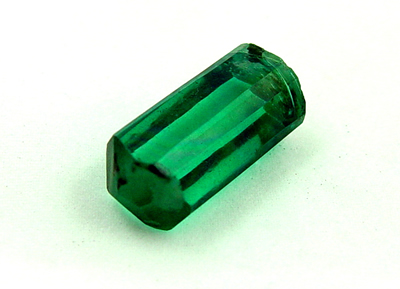
|
1 This high quality hydrothermally lab-grown hexagonal Emerald
crystal has the same geometric atomic structure as a natural emerald.
One of the easiest ways to tell a natural emerald apart from its
lab-grown cousin is that the natural emerald will have many
inclusions.
Of course there can also be low grade lab-grown emeralds that are much
harder to distinguish from naturals. Emeralds, like quartz, grow in
superheated water under extreme pressure, which is why they are called
hydrothermal crystals. |
| |
|
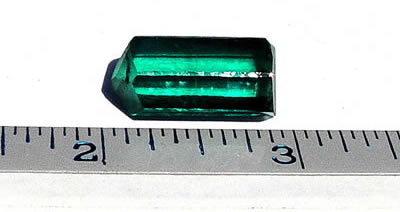 |
2 A raw high-quality hydrothermally lab-grown hexagonal Emerald
crystal, grown in a way that results in the atomic lattice being
identical to that of a natural emerald made by Mother Nature and the
laws of physics.
Many people struggle with the concept of a geometrically shaped
crystal grown in a controlled environment that imitates nature. But at
one fiftieth the price of an untreated natural emerald of the same
quality, most individuals simply can't afford a natural emerald of
this kind of astrological efficacy.
|
| |
|
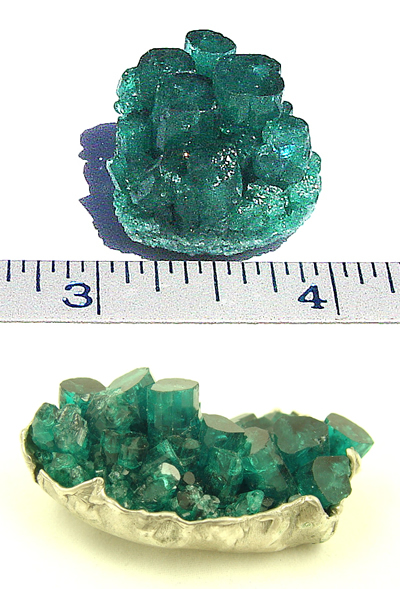 |
3 An example of a low quality laboratory-grown Emerald cluster. At
first sight almost any gemologist will think this is a cluster grown
by Mother Nature, unless they know the lab it came from. |
Ruby
| |
Kashan Created Rublies |
Mined Rubies |
| Chemical composition |
Aluminum oxide |
Aluminum oxide |
| Cause of color |
Chromium oxide |
Chromium oxide |
| Specific gravity |
4.00 |
4.00 |
| Hardness (Moh scale 1-10) |
9 |
9 |
| Refractive index |
1.761 to 1.769 |
1.760 to 1.770 |
| Optical character |
uniaxial - negative |
uniaxial - negative |
| Resistance to heat (Penfield
scale) |
infusible |
infusible |
| Crystal system |
hexagonal |
hexagonal |
| Pleochroism |
violetish-red to orangy-red |
violetish-red to orangy-red |
| Long ultraviolet fluorescence |
strong to very strong |
strong to very strong |
| Short ultra-violet fluorescence
transmission |
moderate to strong |
moderate to strong |
| Short wave ultraviolet transmission |
transparent |
opaque to moderately transparent |
| X-Ray fluorescence |
strong to very strong |
weak to strong |
| X-Ray phosphorescence |
weak to very weak |
weak to strong |
| Cleavage planes |
none |
none |
| Fracture |
conchoidal |
conchoidal |
| Luster |
vitreous to sub-adamantine |
vitreous to sub-adamantine |
| Toughness |
very good |
very good |
| Acid |
resistant to common acids |
resistant to common acids |
This will occur with chemical composition
and subtle variations in other measurable aspects such
as refractive index, e.g. rubies from Australia are quite
different than those from Burma or Vietnam.
Scrupulously grown laboratory rubies will
not only have the same appearance as a flawless natural
ruby (with the expected variations that occur in natural
rubies from different parts of the world) but, more importantly
for our purpose, appear to have the same astrological power
to mitigate and nullify planetary influences on our karma
- at a decidedly lower price! Natural rubies can be prohibitively
expensive, and they are very often color enhanced by being
heat-treated to just below melting point. I have laboratory-grown
rubies from $25-$195 a carat, depending on quality.
Emeralds are also gems of legendary expense,
but fortunately can be grown in the laboratory with great
results. Lab-grown emeralds are easy to identify because
they are usually flawless and of deep green color. Natural
emeralds under the microscope show an extensive "garden" of
inclusions. These inclusions can affect the astrological
potency of the gem. In the case of emeralds, the depth
of green color and uninterrupted amplification of power
given off by an unfractured lab-grown crystal is vastly
superior to a highly included natural emerald of the same
color that would have a carat value (and cost) of at least
40 times the lab-grown crystal. I offer large faceted,
deep green lab-grown emeralds for $55 to $75 a carat.
It is worth noting that most good quality
emeralds have their fractures vacuum acid-cleaned, after
which they are heated and pressure-impregnated with a dyed
synthetic resin with the same refractive index as the beryl
crystal. This process is designed to enhance their appearance
and thereby justify an inflated price. In reality it only
disguises the gems' heavily flawed condition (but such
are the forces that drive the gem market!). Many people
who have had their jewelry cleaned were unaware that the
sonic cleaners had eradicated the coloring agents in their
emeralds and have then sometimes unfairly accused their
jewelers of switching stones!
Rubies, like diamonds, also have a sorry
tale of extreme
"flaw-fixing" remedies which include color enhancing
and glass injection fracture filling, for cosmetic improvement.
When mined, a very high proportion of red or pink rubies
are
"flawed" by color variations such as purple or
black spots. By heating the material to just below the
melting point adversely affecting the crystal structure,
these undesirable qualities can be removed. However, because
of the extraordinarily high temperatures and the difficulty
in detecting this occurrence, a stronger interest has been
generated for the lab-grown crystal material.

Further gem details
Hessonite Garnet  
This gem is perhaps the most varied of
all the primary Ayurvedic gems. Gemologically, there is
more confusion concerning this garnet than any other. Traditionally,
it used to be called cinnamon stone in India. There is
a very large amount of it on the market that has a visible,
roiled appearance, or extensive inclusions. It is one of
the hardest to get inclusion-free with the correct color
and sufficient weight. The crystal clear variety is the
much more valuable. The roiled material sells for around
$20 a carat and is not recommended.
The well-cut, totally clear cinnamon brown
ultra-clean material goes from $85 a carat up to $160 plus.
The jump in price is based on rarity and demand for the
much heavier, flawless stones. Astrologically, my research
tends to advise the much less expensive, tumble polished
material for the budget-conscious. These small, clear,
pebble-like stones have the weight and color but not the
cosmetic symmetry associated with cost, and sell from $8
to $16 per carat. Again, the price variation is dependent
upon the size of the stone, a clean 6-carat, tumble polished
hessonite would be $15 per carat. I also have golden hessonite
that some customers request. This attractive gem sells
from $35 up to $55 a carat.
Flattened laboratory-grown ruby crystals
which are clear, irregularly edged gems, perfect for bangle
settings, normally sell for $25 per carat.
Equal quality laboratory-grown ruby crystal,
but faceted, will sell from $140 to $195 per carat depending
upon depth of color and size.
Ruby   
Good quality natural ruby can go from $550 per carat upwards.
Depth of color, size, and clarity can multiply the price
by five-fold very quickly. And even with gemological analysis
laboratory reports, I am not always completely satisfied
with declarations that the stones haven't been tampered
with (super -fried ). Some of the crystal growing laboratories
do just too good a job of growing the rubies for the gem
testing labs to detect whether they are natural or not.
Buyer Beware.... when buying rubies. 99.9% of them have been superfried at very high temperatures. Disolving the essentila molecular crystal lattice so important for ayurvedic gemstone vibration and electro magnetic radiation. it is essential you buy from a well traveled gem dealer who keeps up with the latest market treatments and how to detect them. So many gem dealers do not care to demand and investigate thouroughly a a gemstones history and are not certified or qualified to identify the color enhancing treatments.
Pearl
Price depends on luster, shape, symmetry, and lack of nacre
blemishes. A smooth, undrilled, non-bleached, tissue grown,
fresh water round pearl will sell by the piece from $75
up to $140.
These are not the bead or seeded cultured
variety. Other irregularly shaped large pearls will generally
sell from $40 each and more.
Naturally occurring salt water pearls
are exceptionally rare and have to be special ordered from
Australia and will sell from $700 upwards for one that
is over five carats of high quality.
Red Coral 
Red coral - or rather orange red coral as
it should be called, as this is the material most commonly
used - is generally $20 dollars plus per carat for higher
quality material. Large, round, undrilled beads (9mm)
due to scarcity can skyrocket up to $80 per carat. Shape
and size has a lot to do with rarity. Its not unusual
to see a large bead (11 mm) red coral necklace sell for
$35,000, though I have 80 carat large rice grain bead
necklaces for $58. There is a tremendous amount of imitation
material on the market including white coral and bone
which is dyed red, ceramic and glass beads.
Emerald  
In my experience, emerald is one of the most
over valued gems on the market, one of the most misrepresented
and fraudulently priced. I have little difficulty selling
the laboratory-grown emerald crystal cut gem stones to
clients when they see the crystals in the raw form and
they compare the price against the heavily included and
extremely expensive natural gem quality emerald which
starts at $190 a carat. And the price keeps going up.
Most clients settle for material priced around $650 a
carat in the higher quality range.
The lab-grown material, which has the
perfect deep green color and is clear of cracks and foreign
matter inclusions, sells from $55 up to $75 a carat and
much less for non-symmetrical cuts. Please remember most
emerald on the market is fracture filled with a plastic
resin or green oil with the same refractive index.
Blue sapphire  
Blue sapphire doesn't seem to have a
lot of price variety unless of course one compromises
price by acquiring a heat-treated stone. These can sell
from $70 a carat and up. The more expensive unheated
blues will go from $190 a carat and up, depending on
the intensity of the natural blue. $290 plus is common
for a good blue. The intense, unheated or non-irradiated
natural blue can go for over $900 a carat. Beware of
the blue sapphires in the local jewelry store. Any honest
Bangkok gem dealer will let you know that 97% of blue
sapphires are generally heated to a little below melting
point in order to deepen the color.
Diamond 
For all my phone work, door knocking, faxing, and plane
travel over the years, still the elusive price break on
high quality, large diamonds hasn't occurred. I do not
favor the Russian laboratory grown diamonds. They simply
do not have all the characteristics the natural diamond
has. It is astrologically important that the gem has no
black carbon inclusions, and is very clean. I often purchase
VVSI or IF diamonds in the light cape color range over
two carts for around $3,000 per carat.
I can explain the purchasing procedure
over the phone to interested parties. I generally suggest
to clients that unless Venus is seriously afflicted in
their horoscopes, it is better to concentrate on acquiring
the eight other stones in the best possible size and quality.
They should wait to add a diamond until they have been
wearing the other stones for awhile and can attest to their
effectiveness.
At the lower end of the price scale I
sell high quality, uncut, natural, clean diamond crystals
- when I can get them at the right price - for $350 per
carat.
Yellow Sapphire  
Very pale yellows start from $90 a carat and work themselves
up to $300 a carat for a good color, unheated stone. Most
yellow sapphires on the market are heated and virtually
all the golden sapphires are also. Heat treated yellows
often color fade within a year or two. Some astrologers
often advise golden topaz as a substitute not realizing
that citrine is often sold by the same name.
I often visit different gem mining areas around the world that offer the best prices for natural unenhanced ayurvedic astrological gemstones. This video discusses some of the procedures hunting for the the appropriate gem crystals while in Sri Lanka.
Chrysoberyl
Catseye   
Here is another complexly priced stone
with many variations.There are many different catseyes
on the market. True chrysoberyl is among the most rare
and expensive. There are opaque and transparent catseyes.
Prices will travel between $90 a carat (which will not
be totally flawless) up to $600 a carat or more.
I commonly sell between the $275 to $380
per carat range
|
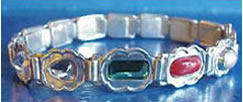
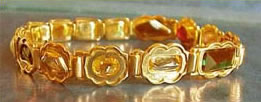
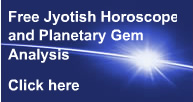
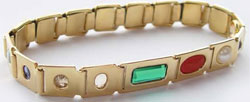



 Many people still believe that high-quality
gems must cost a king's ransom. But in this age of dynamite,
excavators, and mechanized mineral processing technology,
what once came to rest with wealthy collectors is now much more
affordable. Laboratories, using revolutionary techniques
to copy Mother Nature's gem growing environment, have greatly
expanded the supply of top quality gem material, and thereby
reduced its cost.
Many people still believe that high-quality
gems must cost a king's ransom. But in this age of dynamite,
excavators, and mechanized mineral processing technology,
what once came to rest with wealthy collectors is now much more
affordable. Laboratories, using revolutionary techniques
to copy Mother Nature's gem growing environment, have greatly
expanded the supply of top quality gem material, and thereby
reduced its cost. 


